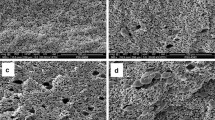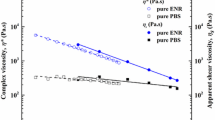Abstract
Novel degradable materials based on ternary blends of natural rubber (NR)/linear low-density polyethylene (LLDPE)/thermoplastic starch (TPS) were prepared via simple blending technique using three different types of natural rubber (i.e., unmodified natural rubber (RSS#3) and ENR with 25 and 50 mol% epoxide). The evolution of co-continuous phase morphology was first clarified for 50/50: NR/LLDPE blend. Then, 10 wt% of TPS was added to form 50/40/10: NR/LLDPE/TPS ternary blend, where TPS was the particulate dispersed phase in the NR/LLDPE matrix. The smallest TPS particles were observed in the ENR-50/LLDPE blend. This might be attributed to the chemical interactions of polar functional groups in ENR and TPS that enhanced their interfacial adhesion. We found that ternary blend of ENR-50/LLDPE/TPS exhibited higher 100 % modulus, tensile strength, hardness, storage modulus, complex viscosity and thermal properties compared with those of ENR-25/LLDPE/TPS and RSS#3/LLDPE/TPS ternary blends. Furthermore, lower melting temperature (T m) and heat of crystallization of LLDPE (∆H) were observed in ternary blend of ENR-50/LLDPE/TPS compared to the other ternary blends. Also, neat TPS exhibited the fastest biodegradation by weight loss during burial in soil for 2 or 6 months, while the ternary blends of NR/LLDPE/TPS exhibited higher weight loss compared to the neat NR and LLDPE. The lower weight loss of the ternary blends with ENR was likely due to the stronger chemical interfacial interactions. This proved that the blend with ENR had lower biodegradability than the blend with unmodified NR.











Similar content being viewed by others
References
Ibrahim A, Dahlan M (1998) Thermoplastic natural rubber blends. Prog Polym Sci 23:665–706
Pechurai W, Sahakaro K, Nakason C (2009) Influence of phenolic curative on crosslink density and other related properties of dynamically cured NR/HDPE blends. J Appl Polym Sci 113:1232–1240
Nakason C, Nuansomsri K, Kaesaman A, Kiatkamjornwong S (2006) Dynamic vulcanization of natural rubber/high-density polyethylene blends: effect of compatibilization, blend ratio and curing system. Polym Test 25:782–796
Nakason C, Jamjinno S, Kaesaman A, Kiatkamjornwong S (2008) Thermoplastic elastomer based on high-density polyethylene/natural rubber blends: rheological, thermal, and morphological properties. Polym Adv Technol 12:85–98
Dierkes W (2007) Raw material and compound in rubber industry, Chap 1. University of Twente, Enschede, pp 6–12
Ishiaku US, Ismail H, Ishak ZAM (1999) The effect of mixing time on the rheological, mechanical and morphological properties of poly(vinyl chloride)-epoxidized natural rubber blends. J Appl Polym Sci 73:75–83
Mousa A, Ishiaku US, Ishak ZAM (2000) Rheological properties of dynamically vulcanized poly(vinyl chloride)/epoxidized natural rubber thermoplastic elastomers: effect of processing variables. Polym Test 19:193–204
Nakason C, Jarnthong M, Kaesaman A, Kiatkamjornwong S (2008) Thermoplastic elastomers based on epoxidized natural rubber and high-density polyethylene blends: effect of blend compatibilizers on the mechanical and morphological properties. J Appl Polym Sci 109:2694–2702
Nakason C, Jarnthong M, Kaesaman A, Kiatkamjornwong S (2009) Influences of blend proportions and curing systems on dynamic, mechanical, and morphological properties of dynamically cured epoxidized natural rubber/high-density polyethylene blends. Polym Eng Sci 49:281–292
Nakason C, Wannavilai P, Kaesaman A (2006) Thermoplastic vulcanizates based on epoxidized natural rubber/polypropylene blends: effect of compatibilizers and reactive blending. J Appl Polym Sci 100:4729–4740
Thitithammawong A, Nakason C, Sahakaro K, Noordermeer JWM (2007) NR/PP thermoplastic vulcanizates: selection of optimal peroxide type and concentration in relation to mixing conditions. J Appl Polym Sci 106:2204–2209
Narathichat M, Kummerlöwe C, Vennemann N, Nakason C (2011) Thermoplastic natural rubber based on polyamide-12: influence of blending technique and type of rubber on temperature scanning stress relaxation and other related properties. J Appl Polym Sci 121:805–814
Mohamad Z, Ismail H, Thevy RC (2006) Characterization of epoxidized natural rubber/ethylene vinyl acetate (ENR-50/EVA) blend: effect of blend ratio. J Appl Polym Sci 99:1504–1515
Nakason C, Tobprakhon A, Kaesaman A (2005) Thermoplastic vulcanizates based on poly(methyl methacrylate)/epoxidized natural rubber blends: mechanical, thermal, and morphological properties. J Appl Polym Sci 98:1251–1261
Pichaiyut S, Nakason C, Kummerlöwe C, Vennemann N (2012) Thermoplastic elastomers-based natural rubber and thermoplastic polyurethane blends. Iran Polym J 21:65–79
Kalkornsurapranee E, Nakason C, Kummerlowe C, Vennemann N (2012) Development and preparation of high performance thermoplastic vulcanizates based on blends of natural rubber and thermoplastic polyurethanes. J Appl Polym Sci 128:2358–2767
Sasdipan K, Kaesaman A, Vennemann N, Nakason C (2014) Influence of blend ratio on properties of novel thermoplastic vulcanizates based on copolyester/epoxidized natural rubber blends. Iran Polym J 21:65–79
Pichaiyut S, Nakason C, Kaesaman A, Kiatkamjornwong S (2008) Influences of blend compatibilizers on dynamic, mechanical, and morphological properties of dynamically cured maleated natural rubber and high-density polyethylene blends. Polym Test 27:566–580
Nakason C, Saiwari S, Kaesaman A (2006) Thermoplastic vulcanizates based on maleate natural rubber/polypropylene blends: effect of blend ratios on rheological, mechanical, and morphological properties. Polym Eng Sci 46:594–600
Nakason C, Saiwari S, Kaesaman A (2006) Rheological properties of maleated natural rubber/polypropylene blends with phenolic modified polypropylene and polypropylene-g-maleic anhydride compatibilizers. Polym Test 25:413–423
Lamlaeh S, Kaesaman A, Nakason C (2013) Thermoplastic natural rubber based on blending of maleated natural rubber and copolyester: effect of blend ratios on mechanical, thermal, dynamic and morphological properties. Adv Mater Res 626:66–70
Sripornsawat B, Nakason C, Kaesaman A (2013) Effect of modified natural rubber on properties of thermoplastic natural rubber based on co-polyamide blends. Adv Mater Res 626:233–236
Nakason C, Pechurai W, Sahakaro K, Kaesaman A (2005) Rheological, mechanical and morphological properties of thermoplastic vulcanizates based on NR-g-PMMA/PMMA blends. Polym Adv Technol 16:592–599
Intharapat P, Derouet D, Nakason C (2010) Thermal and flame resistance properties of natural rubber-g-poly(dimethyl(methacryloyloxymethyl) phosphonate). J Appl Polym Sci 115:255–262
Shi Q, Chen C, Gao L, Jiao L, Xu H, Guo W (2011) Physical and degradation properties of binary or ternary blends composed of poly(lactic acid), thermoplastic starch and GMA grafted POE. Polym Degrad Stab 96:175–182
Kahar M, Wahab A, Ismail H, Othman N (2012) Effect of polyethyl-grafted maleic anhydride as a compatibilizer on the morphology and tensile properties of (thermal tapioca starch)/(high-density polyethylene)/(natural rubber) blends. J Vinyl Addit Technol 18:65–70
Ayana B, Suin S, Khatua BB (2014) Highly exfoliated eco-friendly thermoplastic starch (TPS)/poly(lactic acid)(PLA)/clay nanocomposites using unmodified nanoclay. Carbohydr Polym 110:430–439
Carmona VB, Correa AC, Manoel JM, Mattoso LHC (2015) Properties of a degradable of thermoplastic starch (TPS), poly (ε-carprolactone) (PCL) and poly (lactic acid) (PLA). J Polym Environ 23:83–89
Tena-Salcido CS, Rodríguez-González FJ, Méndez-Hernández ML, Contreras-Esquivel JC (2008) Effect of morphology on the biodegradation of thermoplastic starch in LDPE/TPS blends. Polym Bull 60:677–688
Sabetzadeh M, Bagheri B, Masoomi M (2015) Study on ternary low density polyethylene/linear low density polyethylene/thermoplastic starch blend films. Carbohydr Polym 119:126–133
Róz AL, Ferreira AM, Yamaji FM, Carvalho AJF (2012) Compatible blends of thermoplastic starch and hydrolyzed ethylene-vinyl acetate copolymers. Carbohydr Polym 90:34–40
Carvalho AJF, Job AE, Alves N, Curvelo AAS, Gandini A (2003) Thermoplastic starch/natural rubber blends. Carbohydr Polym 53:95–99
Mondragón M, Hernández EM, Rivera-Armenta JL, Rodríguez-González FJ (2009) Injection molded thermoplastic starch/natural rubber/clay nanocomposites: morphology and mechanical properties. Carbohydr Polym 77:80–86
Kahar AWM, Ismail H (2014) High-density polyethylene/natural rubber blends filled with thermoplastic tapioca starch: physical and isothermal crystallization kinetics study. J Vinyl Addit Techn. doi:10.1002/vnl.21422
Kahar AWM, Ismail H, Othman N (2013) Properties of HVA-2 vulcanized high density polyethylene/natural rubber/thermoplastic tapioca starch blends. J Appl Polym Sci 128:2479–2488
Kahar AWM, Ismail H, Othman N (2012) Effects of polyethylene-grafted maleic anhydride as a compatibilizer on the morphology and tensile properties of (thermoplastic tapioca starch)/(high-density polyethylene)/(natural rubber) blends. J Vinyl Addit Techn 18:65–70
Trovatti E, Carvalhoa AJF, Gandinia A (2015) A new approach to blending starch with natural rubber. Polym Int 18:605–610
Nakason C, Wannavilai P, Kaesaman A (2006) Effect of vulcanization system on properties of thermoplastic vulcanizates based on epoxidized natural rubber/polypropylene blends. Polym Test 25:34–41
Agnantopoulou E, Tserki V, Marras S, Philippou J, Panayiotou C (2012) Development of degradable composites based on wood waste flour and thermoplastic starch. J Appl Polym Sci 126:E273–E281
Bootklad M, Kaewtatip K (2007) Biodegradability, mechanical, and thermal properties of thermoplastic starch/cuttlebone composites. Polym Compos 36:1401–1406
Yokesahachart C, Yoksan R (2011) Effect of amphiphilic molecules on characteristics and tensile properties of thermoplastic starch and its blends with poly(lactic acid). Carbohydr Polym 83:22–31
Shanks R, Kong I (2012) Thermoplastic starch, thermoplastic elastomers. In: El-Sonbati A (ed) InTech. http://www.intechopen.com/books/thermoplasticelastomers/thermoplastic-starch. Accessed 16 May 2016
Pang MM, Pun MY, Ishak ZAM (2013) Degradation studies during water absorption, aerobic biodegradation, and soil burial of biobased thermoplastic starch from agricultural waste/polypropylene blends. J Appl Polym Sci 129:3656–3664
Acknowledgements
This research was supported by the Higher Education Research Promotion and National Research University Project of Thailand, Office of the Higher Education Commission, Prince of Songkla University, Contract No. SIT570565S. The author also would like to acknowledge Dr. Seppo Karilla who contributed to proof this manuscript.
Author information
Authors and Affiliations
Corresponding author
Rights and permissions
About this article
Cite this article
Pichaiyut, S., Wisunthorn, S., Thongpet, C. et al. Novel ternary blends of natural rubber/linear low-density polyethylene/thermoplastic starch: influence of epoxide level of epoxidized natural rubber on blend properties. Iran Polym J 25, 711–723 (2016). https://doi.org/10.1007/s13726-016-0459-z
Received:
Accepted:
Published:
Issue Date:
DOI: https://doi.org/10.1007/s13726-016-0459-z




